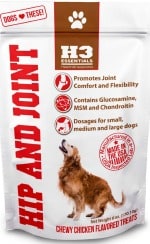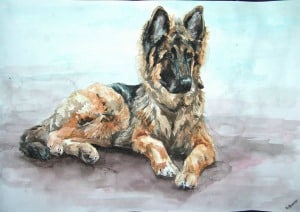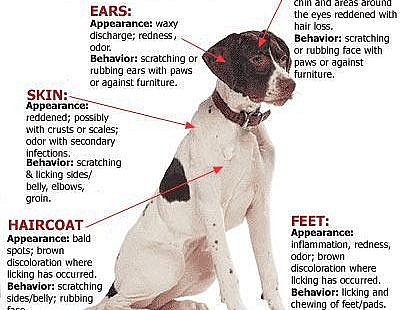It’s painful to see your dog suffer from joint pain. These signs and treatments of hip dysplasia in dogs – inspired by The Parable of the German Shepherd – will help you recognize and treat your dog’s joint pain.
 H3 Essentials Glucosamine for Dogs is a hip and joint supplement with glucosamine, chondroitin, and MSM for maximum mobility, pain relief and joint health for dogs. It’s the number one bestseller on Amazon in dog herbal supplements, and has gotten hundreds of positive reviews from dog owners.
H3 Essentials Glucosamine for Dogs is a hip and joint supplement with glucosamine, chondroitin, and MSM for maximum mobility, pain relief and joint health for dogs. It’s the number one bestseller on Amazon in dog herbal supplements, and has gotten hundreds of positive reviews from dog owners.
I give my dog Georgie adult grade glucosamine for her osteoarthritis, but I don’t know if it’s helped her joint pain. My veterinarian didn’t give me advice on how much glucosamine dogs should be given, so I just sprinkle half a crushed tablet on her breakfast and dinner.
The inspiration for this article on hip dysplasia in dogs is my dog Georgie (and The Parable of the German Shepherd!). She doesn’t have hip dysplasia – I think she has juvenile osteoarthritis. She’s only five years old, but her front legs appear to be bowing out and she walks very slowly. Below I share what my veterinarian said about osteoarthritis in dogs – you’ll find it helpful in your search for information about hip dysplasia in dogs.
The Parable of the German Shepherd
Once upon a time, a poor farmer owned a strong, intelligent, loyal German Shepherd. Whenever noblemen passed through the village, they always noticed the dog and offered the farmer handsome sums of money. He declined their offers to buy the dog, saying, “This dog is my best friend and companion. How can I sell my friend?”
One morning the old man awoke to find his dog was gone. The village people gathered. “You were a fool not to sell the German Shepherd,” they said. “You could have been wealthy! Now your dog has been stolen, and you have nothing. It is a great misfortune!”
But the old farmer replied, “I wouldn’t say that. Whether the dog was stolen or not, or whether it is a misfortune or a blessing, is unknown. All we know is that the dog is not in the stable.”
Some days later the dog returned, bringing several beautiful wild female dogs with him. Again the village people gathered. “You were right,” they said. “The German Shepherd was not stolen, and it was not a misfortune. It was a blessing, and now you have many dogs to work and breed!”
But the old farmer replied, “Again you go too far. We don’t know if it’s a good thing or a bad thing that my dog returned with these other dogs. Whether it is a blessing or a misfortune is unknown.”
Some days later the old man’s only son began to train the dogs to work around the farm. One of the dogs attacked and bit his leg bad enough to break it. The village people were saddened. “You were right, old man,” they said. “It was not a blessing but a great misfortune that your German Shepherd brought these dogs home. Now your only son is lame!

“The Parable of the German Shepherd” image by daphneblake via DeviantArt
But the old farmer replied, “Don’t say it’s a good thing, don’t say it’s a bad thing, just say my son has a broken leg. Whether it is a blessing or a misfortune is unknown.”
A few weeks later the country went to war, and all the able bodied young men were conscripted to serve in the military. Only the old man’s son was passed over, because his leg was broken. The whole village cried for their own sons, whom they believed would die. “You were right,” they said to the farmer. “Your son’s injury was a blessing. Your son may be crippled, but he is with you, while our sons are gone forever!”
The old farmer simply shook his head and said, “We don’t know if it’s good or bad that my son is here, and your sons are not. We will wait and see.”
The moral of this parable? No matter what happens to you and your dog – whether the hip dysplasia is treatable or advanced – keep an open mind and heart. Nothing in and of itself is good or bad. It’s heartbreaking to see your dog in pain, but it gets worse if you try to argue with reality.
Signs of Hip Dysplasia in Dogs
Your heart may sink if you recognize the following signs of hip dysplasia in your dog. I encourage you to remember The Parable of the German Shepherd, and accept that this is your dog’s reality right now. If you can accept hip dysplasia in your dog, then you’ll be in a better position to help treat it and relieve your dog’s joint pain.
Stiff or sore joints when getting up
Hip dysplasia in dogs is evident if they seem hesitant to exercise, stand on their hind legs or climb stairs. A more obvious sign of joint pain is limping or bunny-hopping, and problems getting up. My veterinarian said signs of joint pain and osteoarthritis are more difficult to see in the dog’s front legs. Hind legs tend to be more obvious when it comes to joint pain, so hip dysplasia in dogs is easier to recognize than osteoarthritis.
Painful wear and tear in the hip joints
The signs of hip dysplasia in dogs – which is caused by improperly formed hip joints – result from painful wear and tear in the leg bones. His leg moves around too much, which causes painful wear and tear. Some cases of hip dysplasia in dogs are so mild, you can’t see the signs or symptoms of joint pain. If your dog seems stiff or sore in the hips when getting up, then it’s probably time to ask your veterinarian about hip dysplasia in dogs.
The reason I used The Parable of the German Shepherd in this article about hip dysplasia in dogs is because this is an inherited condition that commonly affects larger breeds of dogs. German shepherds, Rottweilers, Golden Retrievers, Great Danes and St. Bernards are prone to joint pain and problems – but dogs of all sizes and breeds can be born with a predisposition to hip dysplasia.
Treatments for Hip Dysplasia in Dogs
The bad news is that hip dysplasia in dogs can’t be prevented. However, there are some ways to help you manage your dog’s joint pain.
Easing your dog’s joint pain
Just like human muscles and joints, a dog’s muscles and joints benefit from massage, exercise, and a healthy diet. Pain medications can help dogs cope with hip dysplasia. How do you know if your dog is in pain, and how much pain medication to give? You don’t want to overdose your dog, as pain medications cause stomach problems in dogs.
Natural ways to manage hip dysplasia in dogs

Anti-inflammatory for dog joint pain
- Healthy diet
- Maintaining a normal weight
- Exercise
- Massage – read 5 Do-It-Yourself Dog Massage Techniques
- Warm, dry sleeping areas
- Joint supplements, such as the glucosamine supplement for dogs at the top of this article
- Anti-inflammatory liquid supplements for dogs
- Pain-relieving medications
If you decide to give your dog joint supplements or anti-inflammatories for hip dysplasia, check with your veterinarian first. Especially if your dog is on other prescription medications or natural supplements – because even the most natural and organic supplements can interact harmfully and cause health problems in dogs. The last thing you want to do is exacerbate your dog’s hip dysplasia!
To learn more about signs and treatments of other health problems in dogs, read 6 Most Common Dog Diseases.
I welcome your thoughts on the signs and treatments of hip dysplasia in dogs. I can’t offer health advice or veterinarian information, but it may help you to share how you’re coping with your dog’s joint pain.
If you’re upset about your dog’s joint pain, remember The Parable of the German Shepherd. It’s hard to watch your dog cope with something like hip dysplasia – but if you can stay peaceful and calm, your dog will be much happier and in less pain.


